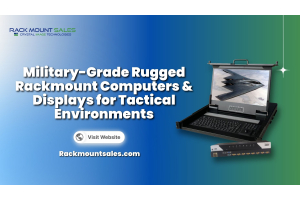Choosing the Right Marine Display for Your Boat: Enhancing Navigation and Performance
Marine displays are essential components of modern boating, providing crucial information and enhancing navigation capabilities. Designed specifically for use in marine environments, these specialized monitors offer durability, functionality, and features tailored to the unique challenges and demands of life at sea. Whether you're a recreational sailor, a commercial fisherman, or a professional mariner, selecting the right marine display is pivotal for optimal performance, reliable data visualization, and seamless navigation. In this comprehensive guide, we will delve into the key factors to consider when choosing a marine monitor display, explore the latest advancements in display technology, and introduce Rackmountsales.com as a trusted retailer of high-quality marine displays.
1. Understanding Marine Displays
1.1 Definition and Purpose:
Marine displays, also known as marine monitors or marine LCD screens, are specialized monitors designed specifically for use in marine environments. They are built to withstand the harsh conditions encountered at sea, including extreme temperatures, humidity, saltwater exposure, and vibrations. Marine displays serve as the primary interface between boaters and vital information such as navigation charts, sonar readings, radar data, engine parameters, and other essential data from marine electronics.
1.2 Importance of Marine Displays:
Marine displays play a pivotal role in enhancing navigation and safety at sea. They provide real-time information, enabling boaters to make informed decisions while maneuvering through waterways, avoiding obstacles, and navigating challenging conditions. With advancements in display technology, modern marine displays offer enhanced visibility, crisp image quality, and features specifically tailored for marine applications, such as sunlight readability, waterproof construction, and compatibility with marine communication protocols like NMEA 2000.
1.3 Durability and Environmental Considerations:
Marine environments present unique challenges for electronic equipment. Marine displays must withstand extreme temperatures, high humidity, corrosive saltwater, constant vibration, and exposure to UV radiation. To ensure durability and longevity, marine displays undergo rigorous testing and adhere to industry standards for environmental resilience.
Marine displays feature robust construction materials, including corrosion-resistant casings, sealed connectors, and reinforced frames. They are often rated with an Ingress Protection (IP) rating to indicate their resistance to dust and water ingress. Common IP ratings for marine displays include IPX6 (water jets) and IPX7 (temporary immersion).
Advanced marine displays incorporate technologies to combat sunlight glare and enhance visibility in bright conditions. These include anti-reflective coatings, polarized filters, and high-brightness backlights that automatically adjust to ambient light levels. These features ensure optimal readability and reduce eye strain for boaters under intense sunlight.
Furthermore, marine displays are designed to handle the vibrations and shocks experienced while navigating rough waters. Internal components are secured using vibration-resistant mounting techniques, and the displays are tested to meet industry standards for shock resistance.
1.4 Integration and Connectivity:
Modern marine displays offer seamless integration with other onboard systems and devices. One of the key integration protocols in the marine industry is NMEA 2000 (National Marine Electronics Association). NMEA 2000 is a standardized communication protocol that allows different marine electronics devices to share data in a networked environment. Marine displays with NMEA 2000 compatibility can connect to various onboard sensors, instruments, and systems, providing a unified interface and enabling data sharing and control.
Integration with NMEA 2000 allows boaters to access a wide range of information and functionality from connected devices. For example, a marine display can receive and display GPS data, depth sounder readings, fuel consumption information, and engine diagnostics. This integration enhances situational awareness, simplifies navigation tasks, and provides comprehensive monitoring of vessel systems.
In addition to NMEA 2000, marine displays may also support other communication protocols such as Ethernet, Wi-Fi, Bluetooth, and USB. These connectivity options allow for easy integration with external devices, such as chartplotters, fishfinders, radar systems, and entertainment systems. Boaters can leverage these connections to access multimedia content, control auxiliary devices, and even stream data from mobile devices or the internet.
1.5 User Interface and Functionality:
Marine displays come in various sizes, ranging from compact screens suitable for small boats to larger displays that cater to the needs of commercial vessels. The size of the display impacts the amount of information that can be displayed at once, as well as the ease of readability. Smaller displays are suitable for limited spaces or when displaying specific data, while larger displays offer more screen real estate for multitasking and displaying detailed information.
The user interface of a marine display should be intuitive and user-friendly, allowing boaters to access and navigate through various functions and settings with ease. Touchscreen functionality is a common feature in modern marine displays, enabling users to interact with the display using familiar gestures such as tapping, swiping, and pinch-to-zoom. Touchscreens provide quick and direct access to menus, charts, and settings, enhancing the overall user experience.
2. Key Features to Consider
2.1 Size and Aspect Ratio:
Choosing the appropriate size and aspect ratio for your marine display is crucial, as it determines the amount of information that can be displayed and how effectively it can be read. Smaller boats may benefit from compact displays, such as 7-inch models, while larger vessels require larger displays, ranging from 10 inches to 24 inches or more, to accommodate the increased screen real estate.
2.2 Resolution and Image Quality:
Display resolution significantly impacts the clarity and sharpness of images on the screen. Higher resolutions, such as Full HD (1920 x 1080 pixels) or even Ultra HD (4K) resolutions, offer more detailed visuals, making it easier to interpret charts, maps, and other critical data. Crisp image quality becomes especially important when relying on the display for navigation purposes.
2.3 Sunlight Readability and Anti-Glare Coatings:
Boating often involves exposure to direct sunlight, which can pose challenges for visibility on standard displays. Sunlight-readable marine displays feature enhanced brightness and anti-glare coatings, ensuring excellent visibility even under intense sunlight. These displays employ high-brightness backlights and advanced polarizers to minimize reflections and provide clear, readable information.
2.4 Waterproof and Weather Resistance:
Marine environments expose electronic equipment to moisture, salt spray, and challenging weather conditions. It is crucial to select a marine display with a robust and waterproof construction that meets or exceeds industry standards for protection against water ingress. Look for displays with an IPX6 or IPX7 rating, indicating resistance to water jets and temporary immersion.
2.5 Touchscreen Capability:
Many marine displays feature touchscreen functionality, allowing users to interact with the display using intuitive gestures. Touchscreens offer convenient operation, especially when navigating through menus, adjusting settings, or zooming in on charts. Capacitive touchscreens, similar to those found on smartphones and tablets, are popular due to their responsiveness and ease of use.
2.6 NMEA 2000 Compatibility:
NMEA 2000 is a standardized communication protocol used in the marine industry for seamless connectivity and data sharing between different onboard devices. Choosing a marine display with NMEA 2000 compatibility allows for integration with other marine electronics, such as GPS systems, sonar modules, autopilot systems, and engine data displays. This integration facilitates a unified and comprehensive view of vital information on a single display.
2.7 Mounting Options and Flexibility:
Consider the available mounting options for your marine display, ensuring compatibility with your boat's existing infrastructure. Common mounting options include flush-mounting, bracket mounting, or the use of adjustable RAM mounts for versatility. Assess the space available on your boat and select a display that can be easily installed and positioned for optimal visibility and convenience.
3. Where to Buy Marine Displays?
When purchasing a marine display, it is essential to choose a reliable retailer that offers high-quality products, knowledgeable customer support, competitive pricing, and favorable warranty and return policies. Rackmountsales.com is a leading retailer specializing in marine displays and related marine electronics. With a wide selection of displays from reputable manufacturers, Rackmountsales provides customers with access to top-tier products that meet the demanding requirements of marine environments. They also offer customization options, allowing customers to tailor their marine displays to suit specific needs and preferences. Rackmountsales.com takes pride in its commitment to customer satisfaction, offering generous warranties and hassle-free return policies, ensuring a positive buying experience.
4. Conclusion
Choosing the right marine display is paramount for a safe, efficient, and enjoyable boating experience. By considering factors such as display size, resolution, sunlight readability, waterproof construction, NMEA 2000 compatibility, and mounting options, boaters can make informed decisions and select the most suitable display for their specific needs. Rackmountsales.com emerges as a trusted retailer, offering a wide range of high-quality marine displays, backed by their commitment to customer satisfaction. By partnering with Rackmountsales.com, boaters can enhance their navigation capabilities, access vital information, and enjoy peace of mind on the water. Contact Rackmountsales.com today to explore their comprehensive selection and elevate your boating experience with a top-of-the-line marine display.











